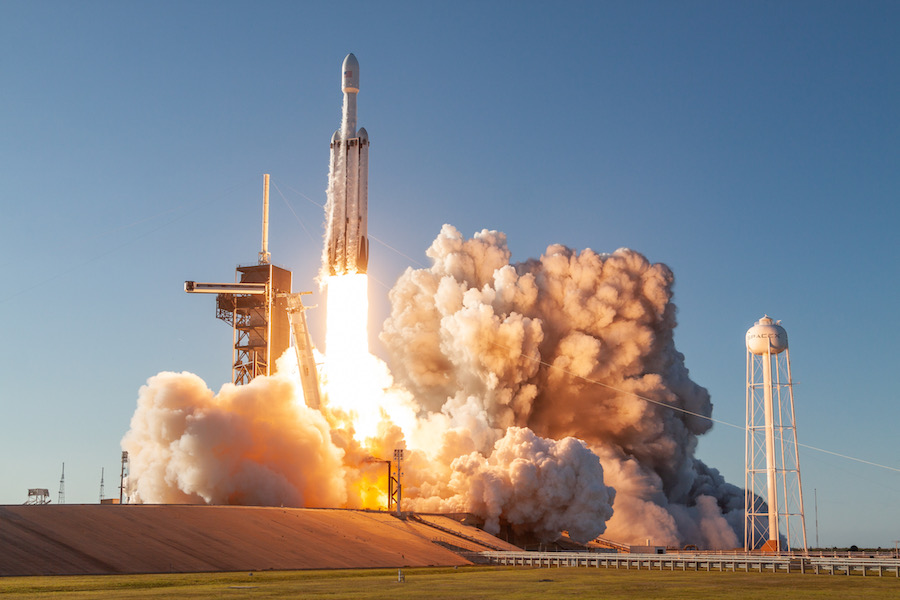
The next launch of a SpaceX Falcon Heavy rocket has been delayed from July to October to await the readiness of its U.S. military payload, and the following Falcon Heavy flight has been rescheduled from late this year to some time in 2022, military officials said.
Col. Robert Bongiovi, head of the launch enterprise at the Space Force’s Space and Missile Systems Center, said Wednesday the USSF-44 and USSF-52 missions — both carrying U.S. military satellites — have been pushed back from their previous target launch dates in July and October.
The missions are the first two launches of SpaceX’s Falcon Heavy rockets to carry the military’s highest-priority national security payloads. The most recent Falcon Heavy launch in June 2019 was also for the U.S. military, but it carried a cluster of lower-priority experimental satellites into orbit.
The USSF-44 mission has moved from a launch date in July to October to “accommodate payload readiness,” according to Col. Douglas Pentecost, deputy director of SMC’s launch enterprise. The following mission, USSF-52, was previously scheduled for launch in October of this year, but has now been moved into 2022 “based on launch manifest priorities,” Pentecost said in a statement released to Spaceflight Now.
The Falcon Heavy missions are expected to be the fourth and fifth flights of SpaceX’s triple-core heavy-lifter. Both launches will take off from pad 39A at the Kennedy Space Center in Florida.
The Falcon Heavy will deliver multiple military payloads to a high-altitude geosynchronous orbit on the USSF-44 mission. The rocket’s upper stage will fire several times to place the satellites into position more than 22,000 miles above the equator.
The upper stage flight profile will include a coast lasting more than five hours between burns, making the USSF-44 mission one of SpaceX’s most demanding launches yet.
On the most recent Falcon Heavy mission, which lifted off in June 2019, the rocket’s upper stage completed four burns over three-and-a-half hours on a demonstration flight sponsored by the Air Force. The STP-2 launch in 2019 served as a pathfinder for the long-duration USSF-44 mission.
The complex orbital maneuvers during the STP-2 mission were required to place 24 satellite payloads into three distinct orbits. They also exercised the capabilities of the Falcon Heavy and its Merlin upper stage engine before the military entrusts the launcher with more critical, and more expensive, operational national security payloads on future flights, such as the USSF-44 mission.
SpaceX won a contract for the USSF-44 launch in February 2019. In the request for proposals for the USSF-44 launch, the military told prospective launch providers to assume the combined mass of two payloads assigned to the mission is less than 8,200 pounds, or about 3.7 metric tons.
The Space Force hasn’t said whether there are still two satellites booked on the USSF-44 mission, or if officials added more secondary payloads since the 2019 contract award. One of the spacecraft on the USSF-44 launch is a microsatellite named TETRA 1 built by Millennium Space Systems, a subsidiary of Boeing headquartered in El Segundo, California.
Military officials said in a statement the TETRA 1 satellite was created to “prototype missions and tactics, techniques and procedures in and around geosynchronous Earth orbit.”
The Space Force has not disclosed any payloads on the USSF-52 launch next year, but military officials wrote in a draft contract solicitation that the mission would deliver a heavy payload to a geostationary transfer orbit, an elongated path around Earth used as a drop-off point for many satellites heading to a circular geosynchronous orbit.
SpaceX has launched three Falcon Heavy rocket missions to date, all successfully. The company has at least eight confirmed Falcon Heavy missions in its backlog, including the USSF-44 and USSF-52 missions for the Space Force, and launches of a Viasat broadband communications satellite and NASA’s Psyche asteroid explorer, both in 2022.
Astrobotic announced in April that a Falcon Heavy rocket will launch its Griffin lander to the moon in 2023 on a mission to deliver a water-scouting NASA rover to the lunar south pole.
A single Falcon Heavy will also launch the first two elements of NASA’s Gateway lunar space station in 2024, and two Falcon Heavy flights will boost Dragon XL cargo missions to the Gateway later in the 2020s.
The Falcon Heavy is made up of three modified Falcon 9 first stage boosters connected together in a triple-core configuration. The rocket’s 27 Merlin main engines produce some 5.1 million pounds of thrust at liftoff, more than any other currently operational rocket.
All of SpaceX’s Falcon Heavy missions currently under contract will take off from Kennedy Space Center in Florida, where the company plans to construct a vertical integration building and shelter to accommodate future Falcon Heavy payloads.
SpaceX will use three newly-manufactured boosters for the USSF-44 mission, and the challenging launch profile will leave no leftover propellant to recover the center core of the Falcon Heavy, according to the Space Force. The core stage will be expended on the launch, while the rocket’s two side boosters will be recovered on two SpaceX drone ships positioned downrange east of Cape Canaveral.
The Falcon Heavy will get more U.S. military launch contracts in the coming years.
The Space Force last year announced multibillion-dollar contracts to fly the military’s most critical national security payloads on United Launch Alliance Vulcan Centaur rockets and SpaceX Falcon 9 and Falcon Heavy launchers through 2027.
Space News reported Thursday that the Space Force and ULA have agreed to move the first military mission assigned to a Vulcan Centaur rocket to an Atlas 5 rocket. That mission, designated USSF-51, is scheduled to launch in 2022.
The Vulcan Centaur’s first national security launch is now scheduled for early 2023 with the USSF-106 mission, Bongiovi said Wednesday. That flight will follow two certification launches of the Vulcan Centaur rocket carrying commercial payloads.
Email the author.
Follow Stephen Clark on Twitter: @StephenClark1.



